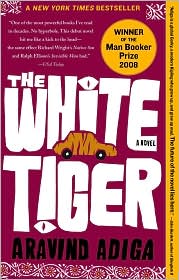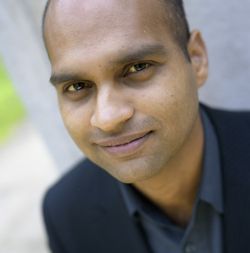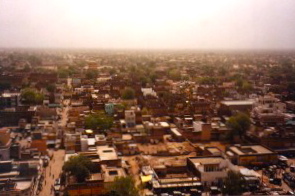Note: This novel was WINNER of the Man Booker Prize in 2008.
“Never before in human history have so few owed so much to so many…A handful of men in this country have trained the remaining 99.9 percent—as strong, as talented, as intelligent in every way—to exist in perpetual servitude; a servitude so strong that you can put the key of his emancipation in a man’s hands and he will throw it back at you with a curse.”
Young Ba lram Halwai, describing himself as “The White Tiger, A Thinking Man, And an Entrepreneur” in Bangalore, has decided to tell the story of his short life to Premier Wen Jiabao of China, who is about to visit the city. Jiabao, according to the local radio station, is on a mission–“He wants to know the truth about Bangalore,” with its burgeoning population of entrepreneurs. Balram decides that “if anyone knows the truth about Bangalore, it’s me.” In a long letter to Jiabao, written over the course of a week, Balram describes his childhood, his escape from the rural Darkness to the city, his slow journey from poverty into a servitude which pays him enough to survive, and ultimately his successful entrepreneurship in Bangalore. He is a “white tiger, that rarest of animals, the creature that comes along only once in a generation.” He is also a wanted man.
lram Halwai, describing himself as “The White Tiger, A Thinking Man, And an Entrepreneur” in Bangalore, has decided to tell the story of his short life to Premier Wen Jiabao of China, who is about to visit the city. Jiabao, according to the local radio station, is on a mission–“He wants to know the truth about Bangalore,” with its burgeoning population of entrepreneurs. Balram decides that “if anyone knows the truth about Bangalore, it’s me.” In a long letter to Jiabao, written over the course of a week, Balram describes his childhood, his escape from the rural Darkness to the city, his slow journey from poverty into a servitude which pays him enough to survive, and ultimately his successful entrepreneurship in Bangalore. He is a “white tiger, that rarest of animals, the creature that comes along only once in a generation.” He is also a wanted man.
A black-humored study of India from the point of view of a “half-baked,” undereducated boy who yearns to be free, Balram’s narrative emphasizes the class divisions: “In the old days there were a thousand castes and destinies in India. These days, there are just two castes: Men with Big Bellies, and Men with Small Bellies.” The Big-Belly class includes government offici als, school administrators, large business owners, lawyers, judges, doctors and hospital administrators, embassy employees, and “public service” officials, all of whom (in this novel) enhance their salaries by extortion, the private sale of public property, and/or the acceptance of bribes. Dealing harsh and sometimes fatal penalties to the Small-Bellies who refuse to pay them in exchange for “favors” which they have often worked tirelessly to achieve, these criminals are among the most successful “entrepreneurs” in the country.
als, school administrators, large business owners, lawyers, judges, doctors and hospital administrators, embassy employees, and “public service” officials, all of whom (in this novel) enhance their salaries by extortion, the private sale of public property, and/or the acceptance of bribes. Dealing harsh and sometimes fatal penalties to the Small-Bellies who refuse to pay them in exchange for “favors” which they have often worked tirelessly to achieve, these criminals are among the most successful “entrepreneurs” in the country.
Growing up in the poor community of Laxmangarh, Balram is a promising student in a school in which his teacher has privately sold their school uniforms and stolen the lunch money appropriated for poverty-stricken children. Balram, however, has to give up a scholarship and drop out of school to work, breaking coals at a tea shop to help pay for his sister’s wedding, the money for which has been borrowed from a criminal money-lender. When he eventually hears that drivers of taxis can earn a good living in a biggercity, he persuades his grandmother to help finance a driving course, and he moves to the city. His grandmother, of course, expects to receive, in exchange, virtually all his salary forever, in support of the family. His job in the city, working for Mr. Ashok and his wife Pinky Madam, as the second driver and servant, provides him with a salary, his meals, and a place to live, and he has few complaints about his treatment.

Laxmangarh town
His crime against Mr. Ashok, his employer, which we learn in the first few pages of the novel, seems inexplicable, at first, but Adiga has cleverly organized the novel to parallel Balram’s increasing awareness of how he is being used—along with his growing understanding of what he needs to do to become a Big-Belly. Imbued with myths and local beliefs from the countryside, nicely incorporated into the narrative, Balram’s understanding of ethics has been limited by the practical necessities of his childhood. Even then “I did my job with near total dishonesty, lack of dedication, and insincerity—so the tea shop was a profoundly enriching experience.” Now working for Mr. Ashok, Balram keeps his eyes and ears open, does what he is told, and looks for a way to escape his servitude.

Adiga creates a unique look at Indian society, one in which Balram, who grew up in poverty, is exposed to the world of the wealthy, having virtually no contact with the middle-class now burgeoning in India. This creates dramatic contrasts in description and characterization, which the author emphasizes through his dark humor, and as suspense builds throughout the novel about how and why Balram commits his crime against his employer, the reader sees that Balram recognizes that such a crime offers him his only chance at freedom, a chance to become a Big Belly himself. Though Balram has been a lovable rogue for much of the book, no one will empathize with him as he commits his crime. And therein lies the greatest strength of the book. Because Balram has elicited our sympathy for most of the book, our shock is increased by his actions, and that, in turn, re-emphasizes the hopelessness of the poor in the face of widespread corruption by the Big Bellies in control.
Notes: The author’s photograph by Mark Pringle appears on his website: http://www.aravindadiga.com/
The photo of Laxmangarh is from http://en.wikipedia.org
The photo of the white tiger is by Sudeshna Banerjee: http://www.tripadvisor.com
ALSO by Adiga: LAST MAN IN TOWER and AMNESTY
